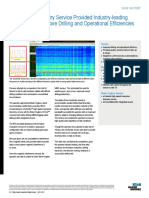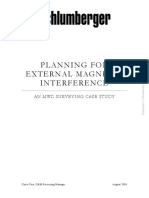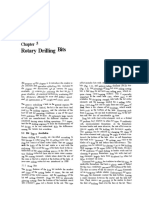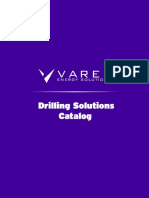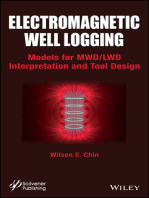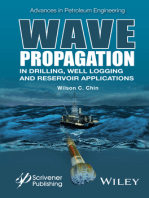Reduce Torsional Vibration and Improve Drilling Operations: Jerome Rajnauth, PHD
Reduce Torsional Vibration and Improve Drilling Operations: Jerome Rajnauth, PHD
Uploaded by
Anonymous DDqgH1Y2MKCopyright:
Available Formats
Reduce Torsional Vibration and Improve Drilling Operations: Jerome Rajnauth, PHD
Reduce Torsional Vibration and Improve Drilling Operations: Jerome Rajnauth, PHD
Uploaded by
Anonymous DDqgH1Y2MKOriginal Title
Copyright
Available Formats
Share this document
Did you find this document useful?
Is this content inappropriate?
Copyright:
Available Formats
Reduce Torsional Vibration and Improve Drilling Operations: Jerome Rajnauth, PHD
Reduce Torsional Vibration and Improve Drilling Operations: Jerome Rajnauth, PHD
Uploaded by
Anonymous DDqgH1Y2MKCopyright:
Available Formats
International Journal of Applied Science and Technology
Vol. 2 No. 7; August 2012
Reduce Torsional Vibration and Improve Drilling Operations
Jerome Rajnauth, PhD
Petroleum Company of Trinidad and Tobago (Petrotrin)
Trinidad and Tobago
Tennyson Jagai, PhD
University of Trinidad and Tobago
Pt. Lisas, Couva
Trinidad and Tobago
Abstract
Torsional vibration can be very damaging to drill string components during downhole drilling operations.
Reducing torsional vibration as a result of monitoring and implementing corrective actions can be very useful in
drilling optimization. While downhole vibrations cannot be totally eradicated, if properly monitored and kept to a
minimum, they are harmless. A software package was used during drilling operations on two wells off the East
Coast of Trinidad. Results showed that severe slip stick vibrations were occurring and having major impact on
downhole equipment such as bit, Measurement While Drilling (MWD) tools and motor. The computer program
provides real time display of the magnitude of torsional vibration by utilizing Fourier Spectral Analysis on the
data from drilling sensors.
This paper will look at the results from these two wells and show that there are benefits from monitoring and
reducing torsional vibrations. These include:
reduction of the frequency of drill string/Bottom Hole Assembly (BHA) failures;
reduction in trip time and fishing time;
increase in drilling rate and bit life
Keywords: Torsional vibration, drilling operations
1. Introduction
Identification and control of drill string vibrations has become an area of considerable interest over the past 10 to
15 years. This is because drill string failures have increased tremendously during that time and have become a
serious problem resulting in substantial financial losses. The financial impact of such failures can be significant
both in terms of cost of replacing damaged components and extended operation time caused by unplanned events.
Increasing drilling costs and the use of more complex and expensive downhole tools make vibration monitoring
and control a key in drilling optimization. A number of oil companies have become aware of the benefits of
controlling vibration and have implemented programs to raise awareness and create control strategies (Kriesels et
al, 1999).
High levels of vibration during the drilling process frequently occur. A combination of technologies and
methodologies can be useful in reduction of downhole vibration (Gabriel et al, 1997). High unacceptable levels of
vibration can result in drill string failure, premature bit failure, poor directional tendency, hole enlargement,
stalling of the top drive or rotary table, MWD tool failure and Stabilizer / tool joint wear. Torsional or slip stick
vibrations are often regarded as one of most damaging modes of vibration (Omajuva et al). This paper looks at the
problem of stick slip during drilling by identifying and determining the magnitude of drill string torsional
vibration using a computer program and monitoring data from drilling sensors. The detailed Fourier spectral
analysis of this data provides a real time display of the magnitude of torsional vibrations (Kt) in the drill string.
This value is the amplitude of the highest resonant frequency detected in the torque signal expressed as a
percentage of the maximum torsional output of the rotary system.
109
Centre for Promoting Ideas, USA
www.ijastnet.com
2. Vibration Background
A drill string can vibrate in three modes, laterally, axially and torsionally. Axial vibration is motion along the drill
string axis, lateral vibration is a side to side motion of the drill string and torsional vibration is a twisting or
motion causing varying levels of torque in the drill string.
Slip stick or stick slip is the non uniform rotation of the drill string caused by resistance to motion traditionally
regarded as resistance by the formation to the cutting action of the bit. Research has shown that slip stick may
occur at any point in the drill string where the resistance is sufficiently high to impede rotation. Slip stick is the
primary mechanism for the creation of torsional vibration within drill string. These occur in the range of up to 1
Hz. A rule of thumb is that the period of vibration is 2 seconds per 1000m for 5 drill pipe.
The rotation of the drill string is impeded to a level close to or above the energy level being imparted to drill
string by the rotary drive. The subsequent increase in torque applied by the motor to overcome this resistance,
causes greater twisting to the drill pipe section and storage of the energy. Once the resistance to rotation is
overcome, the stored energy in the drill pipe is transferred to the BHA and it accelerates to speeds of 3 to 15 times
the current rotary speed.
The repeated acceleration and deceleration of the drill string components has a number of detrimental effects
(Abbassian, 1994). When the BHA is accelerated forward, if the stored energy in the drill string is sufficient, it
twists the drill string from the bit upward past its neutral position. When the drill string tries to return to
equilibrium the bit, BHA and part of the drill pipe then rotate backwards. Fig. 1 shows the cycle of the slip stick
phenomenon highlighting the changes of the drill string during the torsional vibration occurrence. Fatigued of the
drill pipe and BHA connections are increased and because of this increase and reduction in torque, the life span of
the drill pipe is reduced and additional fatigue cracks can develop into washouts.
In extreme circumstances, connections are backed off incurring the costly expense of fishing or sidetracking
around the obstacle. The behavior also causes impact and abrasion damage to stabilizers and bits, especially PDC
bits because they are highly susceptible to damage when rotated backwards. Damage to the rotary drive is may
occur from the high cycling torque.
3. System Layout and Software Program
A software package was used on trial during drilling operations on two wells off the East Coast of Trinidad.
Figure 2 shows the hardware layout of the torsional vibration monitoring program. The diagram shows data from
rig sensors are passed through a filter board and the output signal for display and recording of Kt magnitude is
obtained.
The computer program was used to analyze the magnitude of torsional vibrations using Fourier analysis.
Torque is a complex waveform created by cumulative resistance to rotation of the entire drill string. By analyzing
the power input to the rotary drive, and using fourier analysis, the torque signal could be broken down into its
constituent components, and repetitive cycling waves and respective frequencies identified. These cyclic
frequencies indicate the presence of torsional vibration. Thus the program uses fourier analysis to breakdown the
torque signal and provides a frequency domain spectrum of the amount of energy contained within the sinusoidal
oscillation of the torque signal. These sinusoidal oscillations in the torque are caused by torsional vibrations. This
is shown in Figure 3.
The determination of these frequencies and their magnitude (Kt) allows the driller to correct the problem by
varying the associated drilling parameters of Revolutions per Minute (RPM) and/or Weight on Bit (WOB).
The resulting benefits can bring substantial cost savings to a drilling program by reducing BHA and tubular
failures, reducing bit damage and increasing bit life, decreasing the number of bit trips, reducing tool failures and
determining optimum rotational speed
When a predetermined threshold of torsional magnitude is exceeded a data file is created. The program then
creates an event listing of these data files. The listing contains file name, start and end times and depths of event
files. This event listing is useful in determining the amount of torsional vibration for each bit run.
110
International Journal of Applied Science and Technology
Vol. 2 No. 7; August 2012
Two database files are stored for each bit run. One gives a catalogue of event files showing File Name, Date, Start
and Stop Times, Start and Stop Depths. The other keeps a record of Date, Time, Cycles/Min., Kt Values and Bit
Depth.
These files can be used to determine the duration of each event file, the footage made for the duration of each
event file, the duration of torsional vibration for the bit run, whether the vibration is at the bit or BHA and the
amount of times torsional vibration had exceeded the threshold
Also included in the software package is a playback facility which allows the playback of each event file. This
system helps in the analysis of event recording files and printing playback charts which show stick slip
occurrences and torsional vibration. The torsional vibration system is shown in Figure 4. It shows the playback
facility, Kt levels on drillers display and the real time monitoring of torque levels.
Figure 5 shows a typical playback chart with four traces color-coded as: green hook load (HL); light blue
stand pipe pressure (SPP); deep blue revolutions per minute (RPM). Torque is normally black but when the
torsional vibration limit is exceeded it changes to red. The positions of the zero baselines for these 4 parameters
are indicated on the figure and were chosen so as to minimize overlap of their traces.
Each division on the playback chart is equivalent to 10 seconds on the x-axis and 10% of the baseline values on
the y-axis. These baseline values are set for normal drilling using the drillers gauges on the rig floor.
Additional information that was required for this vibration analysis was obtained from Mudlogging (SDL) data.
ASCII data such as rate of penetration, weight on bit, surface RPM were captured in excel format from SDL Log
Drawing System. Some MWD data (gamma and resistivity) were also obtained from the SDL logs. Bit data was
obtained from the bit record report (Mudlogging Report).
Selecting a threshold value for Kt is pretty much subjective and as a result depends on the operators discretion
and foresight. At the start of drilling, Kt levels would be monitored for some time to determine a trend for normal
drilling. In this case Kt was averaging 0 to 2.5. Thus 0 to 3 was taken as normal drilling for this field and the
threshold set at Kt = 3. Above this value the program would be triggered into creating and storing data files. Once
this threshold had been established, it was used for all the bit runs. While this threshold value would vary from
field to field and country to country, generally regardless of field or country harmful drilling would be in the
range 3 to 8.
4. Field Trial
Drilling wells in Trinidad have resulted in increased drilling cost due to unscheduled events such as downhole
tool failures. These include motor failure, bit failure and MWD failure. Most wells drilled in Trinidad have been
drilled without real time downhole vibration measurement tools used with MWD tools. This is so because of high
cost associated with using the downhole vibration measurement tools.
The torsional vibration-monitoring program was used during the drilling operations of two wells off the East coast
of Trinidad as a trial. The field contains both oil and gas and consists of interbedded formations of sandstone and
claystone. There were numerous downhole tool and bit problems on most of these wells.
The objective of drilling both wells was to penetrate the oil leg and drill lateral sections for a total length of about
2000 ft. To achieve the well objectives, both wells were drilled from the same slot of the platform utilizing twin
monobore wellhead technology.
Seven bit runs were made in drilling Well 1. The software program was used for bit runs 2, 3, 4 and 6 but not for
bit runs 1, 5 and 7. Nine bit runs were used to drill Well 2. The software program was used for bit runs 2, 3, 4, 5,
7 and 8 but was not used for bit runs 1, 6 and 9. Torsional vibration was very evident while drilling both wells.
Many stick slip occurrences were recorded on bit runs 2, 3, 4 and 6 of Well 1 and bit runs 2, 3, 4, 5, 7 and 8 of
Well 2. An event file analysis was done for each bit run. The following discussion focuses mainly on bit run 2 of
Well 1but also includes examples from bit run 3 of Well 1 and bit run 2 of Well 2.
111
Centre for Promoting Ideas, USA
www.ijastnet.com
4.1 Motor Failure - Well 1 Bit Run 2
During bit run 2 of well 1, a Polycrystalline Diamond Compact (PDC) bit was used to drill the 12 hole section
from 4030 ft to 4846 ft. The section was drilled in 7.0 bit hours at an average rate of penetration of 117 ft/hr. A
total of 34 data files were created for this bit run including the period of drilling cement. There were 13 periods of
torsional vibration over 5 minutes, 7 periods of torsional vibration while rotating off bottom and 24 stick slip
occurrences. Total torsional vibration time was 3 hrs and 47 minutes equivalent to 54.3 % of the total drilling
hours for this bit run. Figure 6 shows the periods for Kt values of 5 and greater, the depths at which they occurred
and the length of time in minutes for which they were sustained. There were 6 periods of torsional vibration with
Kt levels between 7 and 9 which was equivalent to 2500 ft lbs and 4500 ft lbs respectively. Each of these lasted
for more than 10 minutes. At depths of 3925 ft and 4363 ft the Kt values were 9 and 7 respectively and each
lasted for 23 minutes. At 4658 ft the Kt value was 9 and lasted for 28 minutes. This data clearly shows that there
were significant levels of damaging torsional vibration that adversely affected the downhole motor that eventually
failed during this bit run.
4.2 Reduction of ROPs - Well 1 Bit Run 2
When stick slip occurs the bit stops rotating and the Rate of Penetration (ROP) decreases. Figure 7 shows some of
the depths at which stick slip occurred for this bit run and the rates of penetration before and after it occurred.
ROPs decreased by more than 50% at the depths 4359 ft, 4367 ft, 4389 ft, 4710 ft. Kt values for these depths
ranged from 6.7 to 8.6.
4.3 MWD Decoding Problems - Well 1 Bit Run 3
Decoding problems and MWD tool failures seem to persist on every well drilled in this field. Decoding problems
are associated with temporary loss of gamma ray and resistivity data. Both of these are important in the
determination of lithology, pore pressure and hydrocarbon bearing zones.
During bit run 3 Well 1, a PDC bit was used to drill the 12 hole section from 4846 ft to 10,319 ft. There were
several instances of MWD decoding problems. These were correlated with stick slip occurrences and a few are
shown in Figures 8 and 9. Figure 8 shows loss of gamma ray and resistivity data on a MWD log while Figure 9 is
a playback chart of these same stick slip occurrences.
Stick slip occurred at 5294 ft with consequent loss of MWD data between 5300 ft and 5330 ft. Torsional vibration
was controlled at 5327 ft by briefly increasing the RPM, Figure 10. This resulted in restoration of MWD data
between 5340ft and 5360ft. The loss of signal again between 5370 ft and 5390 ft prompted a further adjustment to
the RPM. The MWD data collection was then restored beyond 5390 ft.
4.4 MWD Failure - Well 2 Bit Run 2
During bit run 2, Well 2 a PDC LA330BG bit was used to drill the 12 hole section from 4020 ft to 8404 ft.
This bit run started with MWD decoding problems and as torsional vibration persisted and was not controlled,
MWD failure occurred. Figure 11 shows loss of MWD data at several depths starting at 6210 ft while a playback
chart for the depth 6254 ft is shown in Figure 12. It is clear that stick slip was occurring at the same interval
MWD decoding problems were being experienced. An attempt to correct this problem was made at 6913 ft by
reducing the RPM which decreased the torque, Figure 13. However it appeared that this corrective action was
implemented too late and stick slip continued at the other depths as indicated by the loss of MWD data shown in
Figure 11 and eventually MWD failure.
4.5 Torsional Vibration Reduction - Well 1 Bit Run 3
At about a depth of 4979 ft the play back chart was similar to that of Figure 9 and showed rapid fluctuations in
torque as high as 15% above the baseline value. As soon as the RPM was increased torsional vibration began to
stabilize and a reduction in torque was realized.
There are instances where it is necessary to reduce the RPM in order to decrease torsional vibration (Figure 13).
At a depth of 6913 ft erratic fluctuations in torque were occurring with values reaching 20% above the baseline
value. In this case the reduction in torque and torsional vibration were achieved by decreasing the RPM.
112
International Journal of Applied Science and Technology
Vol. 2 No. 7; August 2012
This emphasizes that monitoring torsional vibration can allow the driller to make simple adjustments to rotary
speed and/or weight on bit to effectively control torsional vibration. This was accomplished by monitoring the rig
floor gauge together with advice from engineers analyzing torsional vibration.
4.6
Dogleg Severity
Dogleg is a deviation in the borehole of the well and is created to build angles in inclined holes. The
recommended dogleg for drilling both wells was 2.5 degrees per 100 ft. Figures 14 and 15 show plots of
Measured Depth vs Dogleg for both wells. Substantial torsional vibration levels were occurring where dogleg
exceeded the recommended limit. The evidence for this is the number of data files that were created and the
number of stick slip occurrences. For Well 1 dogleg was above the recommended limit while drilling through the
interval 7125 ft to 8180 ft and 9075 ft to 10,800 ft. During this period 18 torsional vibration data files were
created and there were 6 stick slip occurrences. For Well 2, in the regions 8500 ft to 10,400 ft, where the
recommended dogleg was exceeded, and 60 torsional vibration data files were created.
4.7 Bit Correlation
For both wells more torsional vibration was obtained when PDC bits were used as opposed to rock bits. PDC bits
were used for bit runs 2 & 3 of well 1 and bit run 2 of well 2. For bit run 2 there were 31 stick slip occurrences
while drilling 816 ft (Figure 16).For bit run 3 there were 37 during the drilled interval of 5473 ft. When a Tricone
bit was used there were 5 stick slip occurrences and the footage made was 1425ft.
For well 2 stick slip occurred 36 times during bit run 2 when a PDC was used (Figure 17). The footage made for
this bit run was 4384 ft. For this same well when a Rock bit was being used there were 12 stick slip occurrences
during the drilled interval of 2025 ft. During the bit run for this well when a Devil Drill bit was used there were
24 stick slip occurrences and the footage made was 2659 ft. It is interesting to note that PDC bits use shearing
action while rock bits use compression as the means of cutting the encountered formation.
4.8
Lithology
High torsional vibration and stick slip occurrences were generally observed in the sandstone sections, while lower
levels of torsional vibration were evident in claystone beds. For well 1 bit run 3, there were 31 occurrences of
stick slip in sandstone sections as opposed to 6 in claystone. For all bit runs the majority of the stick slip
occurrences were observed in sandstone (Fig 18).
5. Summary
1. The computer program was used
- To determine the optimum RPM for each bit run.
- In the reduction of BHA and tubular failures.
- In the reduction of bit damage and increase bit life.
- To confirm the hypothesis that severe stick slip vibrations were occurring and having a major impact on
downhole equipment such as bit, MWD and motor, especially while drilling abrasive sands.
-To identify instances when Kt values were greater than 3 during the drilling of both wells.
2. The Playback facility of the computer program allowed detailed analysis of historical drilling data, which was
used to help avoid problems in subsequent bit runs.
3. The data obtained from monitoring torsional vibration can be used for interpretations related to lithology, bit
wear and drill string/borehole interactions.
4. A thruster was used during bit runs 2 and 3 of Well 1. This tool operates in a sense to minimize axial
vibration. However, many stick slip occurrences were evident in both bit run # 2 and bit run #3, which led to
motor failure and MWD decoding problems. This indicates that MWD decoding problems, motor failure for
bit run #2 and bit run #3 were as a result of torsional vibration and not axial vibration as was previously
believed.
5. PDC bits use the mechanism of shearing rock dislocation. For both wells, it appears that more torsional
vibrations were obtained when PDC bits were used as opposed to rock bits as evident by the number of major
stick slip occurrences
6. Frequency of Stick slip is dependent on
(a) Type of formation (often in abrasive sands)
113
Centre for Promoting Ideas, USA
(b)
(c)
(d)
7.
8.
9.
10.
11.
12.
6.0
www.ijastnet.com
Type of bit (higher frequency with PDC bits)
Type of BHA
Possibly amount of doglegs
Stick slip was reduced by either increasing rotary speed and reducing weight on bit OR decreasing rotary
speed and increasing weight on bit.
Previous experience has shown that torsional vibration tends to increase in severity above 30 degrees. It was
noticeable that an increase in the severity of torsional vibration occurred when dogleg was above the
recommended 2.5 degree/100 ft. This sudden increase in inclination increased the friction between the
wellbore and drill pipe.
The periods where the bit stopped rotating were identified. These ranged from 1 second to 40 seconds.
Maximum instantaneous RPM were several times higher than the average surface rotary speed.
The ROPs were significantly reduced after the occurrence of stick slip.
Drilling efficiency can be increased by monitoring and analyzing drill string torsional vibrations. This can
then be used to determine optimum drilling parameters as the well is being drilled. This can result in
reduction in the frequency of drill string failures, the amount of time spent tripping and/or fishing and an
increase in both bit life and penetration rate.
The overall success of this system is dependent on the willingness of the rig crew to make the required
corrections when necessary.
Nomenclature
BHA --- Bottom Hole Assembly
BP
--- British Petroleum
HL
--- Hook Load
Kt
--- magnitude of Torsional vibration in the drill string
LDS --- Log Drawing System
LWD --- Logging While Drilling
MD
--- Measured Depth
MWD --- Measurement While Drilling
PC --- Personal Computer
PDC --- Polycrystalline Diamond Compact
POOH --- Pull Out Of Hole
ROP --- Rate of Penetration
RPM --- Revolutions Per Minute
SDL
--- Surface Data Logging
SPM --- Strokes per Minute
SPP
--- Stand Pipe Pressure
TD
--- Total Depth
TRQ --- Torque
WOB --- Weight On Bit
Devil Drill Run --- Clean Out Assembly using a bit called devil drill
Hydra Thruster --- Tool used on the BHA to cushion axial vibration and stabilize Downhole WOB
7.0
References
Kriesels, P.C., W.J.G Keultjes, P. Dumont, I. Huneidi, O.O. Owoeye, R.A. Hartmann. Cost Savings through an Integrated
Approach to Drillstring Vibration Control. SPE/IADC 57555, 1999.
Gabriel, P., G. Sotomayor, J. C. Placido, J C. Cunha. Drill String Vibration: How to Identify and Suppress. SPE 39002, 1997.
Omajuva, E, Osisanya, S, and Ahmed R. Measuring and Controlling Torsional Vibrations and Slip Stick in a Viscous
Damped Drill String Model. Paper IPTC 14241 presented at 2011 International Petroleum Conference, Bangkok,
Thailand, 1517 November.
Fereidoun Abbassian. Drill String Vibration Primer BP Exploration. Jan 1994
Mudlogging End of Well Report for Wells 1 and 2 (ASCII Data, Bit run Information, End of Well Logs and Geology reports)
Fear, M.J., F Abbassian, S.H.L. Parfitt, A. McClean. The destruction of PDC bits by Severe Slip-Stick Vibration. SPE/IADC
37639, 1997
114
International Journal of Applied Science and Technology
Vol. 2 No. 7; August 2012
Figure 1 Drill String Slip Stick Cycle
Sensors
TRQ
RPM
HL
SPP
Sensor
Interface
Panel
Kt
Magnitude
Mud
Logging
PC
RS232
comms
Rig Floor Display
Filter Board
PC
Figure 2 System Layout: Mud logging Unit
115
Centre for Promoting Ideas, USA
Figure 3 Fast Fourier Transform quantifying torsional vibration
Figure 4 Torsional Vibration Monitoring Output Screens
116
www.ijastnet.com
International Journal of Applied Science and Technology
RPM & Torque for
normal drilling
Acceleration of bit and
BHA. Repeat twisting of
pipe
Vol. 2 No. 7; August 2012
Bit spins free. RPM is
approx. 10% higher than
normal
Zero
base
line
HL
SPP
RPM
TRQ
RPM drops down (10-20%). Bit speed temporarily reduced.
Bit and possibly the whole drill string comes to a halt.
Torque also goes down.
Figure 5 Playback for Well 1 Bit Run 3 - Depth 6244 ft
Figure 6 Well 1 Bit Run 2 Kt and Duration
117
Centre for Promoting Ideas, USA
www.ijastnet.com
Figure 7 Well 1 Bit Run 2 Rate of Penetration
Figure 8 MWD log Well 1 Bit Run 3
118
International Journal of Applied Science and Technology
Vol. 2 No. 7; August 2012
Figure 9 Playback for Well 1 Bit Run 3 - Depth 5294 ft
Figure 10 Playback for Well 1 Bit Run 3 Torsional Vibration Reductions
119
Centre for Promoting Ideas, USA
www.ijastnet.com
Figure 11 Mud log Well 2 Bit Run 2
Figure 12 Playback for Well 2 Bit Run 2 Depth 6254 ft
120
International Journal of Applied Science and Technology
Vol. 2 No. 7; August 2012
Figure 13 Playback for Well 2 Bit Run 2 Torsional Vibration Reduction
Figure 14 - Well 1 Dogleg & Torsional Vibration
121
Centre for Promoting Ideas, USA
www.ijastnet.com
Figure 155 - Well 2 Dogleg & Torsional Vibration
Figure 16 - Well 1 PDC vs. Rock Bit
122
International Journal of Applied Science and Technology
Vol. 2 No. 7; August 2012
Figure 117 - Well 2 PDC vs. Rock Bit
Figure 18 - Well 1 Bit Run 3 Slip Stick Frequency
123
You might also like
- Mapeh Least Learned Competencies 6Document5 pagesMapeh Least Learned Competencies 6Anonymous QnNICuArTx75% (12)
- Oil and Gas - Drilling Bit CatalogDocument98 pagesOil and Gas - Drilling Bit CatalogMocho SedrickNo ratings yet
- Baker Hughes 43018 Axcelerate in Gom CHDocument1 pageBaker Hughes 43018 Axcelerate in Gom CHArumugam RajendranNo ratings yet
- 9.5in OntrakDocument2 pages9.5in OntrakPaul Ticona SNo ratings yet
- Smith BitDocument4 pagesSmith BitRio RizkiNo ratings yet
- 17.5 XT1GRC 536283Document1 page17.5 XT1GRC 536283diegoilNo ratings yet
- Introduction To Measurement While Drilling (MWD) : Study QuestionsDocument55 pagesIntroduction To Measurement While Drilling (MWD) : Study Questionssong LiNo ratings yet
- Multiple Propagation ResistivityDocument2 pagesMultiple Propagation ResistivityQiang ZhangNo ratings yet
- Measurement While Drilling: Signal Analysis, Optimization and DesignFrom EverandMeasurement While Drilling: Signal Analysis, Optimization and DesignNo ratings yet
- Cutting Efficiency With PDC BitDocument6 pagesCutting Efficiency With PDC BitDanny RevillaNo ratings yet
- SPE-14765-MS-Applications of A BHA Analysis Program in Directional DrillingDocument10 pagesSPE-14765-MS-Applications of A BHA Analysis Program in Directional Drillingsaeed65No ratings yet
- PDC Bit DesignDocument5 pagesPDC Bit Designsuresh_501No ratings yet
- 6-Measurement While DrillingDocument5 pages6-Measurement While Drillingمحمد سعيدNo ratings yet
- CD 101 PresentationDocument20 pagesCD 101 PresentationkrishnsgkNo ratings yet
- 10 - UiTM Presentation Bit BHA Drilling Technology RevCDocument10 pages10 - UiTM Presentation Bit BHA Drilling Technology RevCNaufal Syafiq Mohd IsaNo ratings yet
- A Technological Leap Through Automated Directional Drilling in The Rotary ModeDocument16 pagesA Technological Leap Through Automated Directional Drilling in The Rotary ModeTural EmirliNo ratings yet
- Azimuthal GammaDocument10 pagesAzimuthal GammaTom ArnoldNo ratings yet
- LTK 70 01 003Document2 pagesLTK 70 01 003romeoleonNo ratings yet
- 12 BT 0123 Stinger North Dakota CsDocument2 pages12 BT 0123 Stinger North Dakota CsdiegoilNo ratings yet
- What Is Measuring While Drilling (MWD) ?: Source: Accu Tech The MWD CompanyDocument3 pagesWhat Is Measuring While Drilling (MWD) ?: Source: Accu Tech The MWD CompanyAnonymous AkV8maWxGN0% (1)
- MWD BosDocument15 pagesMWD Bosarifin ubaidNo ratings yet
- 4) +DGA Pre-Read DirectionalDocument19 pages4) +DGA Pre-Read DirectionalyuriiNo ratings yet
- TelemetryDocument26 pagesTelemetryWassef MBNo ratings yet
- Monitoring Drilling Bit Parameters Parameters Allows Optimization of Drilling RatesDocument16 pagesMonitoring Drilling Bit Parameters Parameters Allows Optimization of Drilling RatesAnmol JassalNo ratings yet
- 2006-2007 Varel FixedCutterBitsCatalogDocument24 pages2006-2007 Varel FixedCutterBitsCatalogAndrzej KonopkaNo ratings yet
- Presentation2 Rotary Steerable System and Deepwater Operations BSU Symposium 19 Oct 2019Document82 pagesPresentation2 Rotary Steerable System and Deepwater Operations BSU Symposium 19 Oct 2019Lemuel Violante100% (2)
- 7 Icruise Downlink AnalysisDocument44 pages7 Icruise Downlink AnalysisJuan Carlos QuicenoNo ratings yet
- MWD Mechanics: How Is This Data Communicated To The Surface While Drilling Ahead?Document26 pagesMWD Mechanics: How Is This Data Communicated To The Surface While Drilling Ahead?Ali Chouaya100% (1)
- Mainan DewasaDocument153 pagesMainan DewasaHeris SitompulNo ratings yet
- Nation 16 3 Hour On: Pet-A, Oil Gas Well Drillin Ompletion For 016Document7 pagesNation 16 3 Hour On: Pet-A, Oil Gas Well Drillin Ompletion For 016سالم العيساويNo ratings yet
- Gyropulse PDFDocument4 pagesGyropulse PDFCristhian AyanomeNo ratings yet
- 4 75in OTK 100278Document2 pages4 75in OTK 100278Qiang ZhangNo ratings yet
- Mdi 813Document1 pageMdi 813pendexxNo ratings yet
- APS SWD MWD LWD SystemsDocument4 pagesAPS SWD MWD LWD SystemsLauro De Jesus Yañez100% (1)
- 4 - in HSD High Shot Density Perforating Gun SystemDocument2 pages4 - in HSD High Shot Density Perforating Gun SystemSer YouNo ratings yet
- 9 1/2" Autotrak RCLS: Technical Data SheetDocument2 pages9 1/2" Autotrak RCLS: Technical Data SheetTamer Hesham AhmedNo ratings yet
- Planning For External Magnetic Interference: An MWD Surveying Case StudyDocument11 pagesPlanning For External Magnetic Interference: An MWD Surveying Case StudyOscar Salinas JimenezNo ratings yet
- Near Bit GammaDocument2 pagesNear Bit GammaQiang ZhangNo ratings yet
- SLB ArcDocument1 pageSLB Arcbangsawanarief1989No ratings yet
- 8-1/4" Lithotrak: Accurate Density PorosityDocument2 pages8-1/4" Lithotrak: Accurate Density PorosityDavid Lionel Fernandez ValdiviaNo ratings yet
- Champ Ion PackerDocument2 pagesChamp Ion PackerCHO ACHIRI HUMPHREYNo ratings yet
- Confined Compressive Strength Model of Rock For Drilling OptimizationDocument7 pagesConfined Compressive Strength Model of Rock For Drilling Optimizationodex100% (2)
- Halliburton - FX Series™ Performance Drill Bits - h07259.2 PDFDocument2 pagesHalliburton - FX Series™ Performance Drill Bits - h07259.2 PDFandrzemaNo ratings yet
- Powerdrivexceed PDFDocument7 pagesPowerdrivexceed PDFAnonymous HrTzKENo ratings yet
- Introduction To Bits For Oil Well Drilling Introduction To Diamond BitsDocument9 pagesIntroduction To Bits For Oil Well Drilling Introduction To Diamond BitsRebar KakaNo ratings yet
- 04a Surveying ToolsDocument53 pages04a Surveying ToolssauloeganaNo ratings yet
- The Evolution of Real-Time Torque & Drag Analysis From Manual Local Usage To Automated Cloud-Based AnalyticsDocument22 pagesThe Evolution of Real-Time Torque & Drag Analysis From Manual Local Usage To Automated Cloud-Based AnalyticshamayunNo ratings yet
- Motor Operations HandbookDocument179 pagesMotor Operations HandbookScience & EngineeringNo ratings yet
- Drilling Bits SPE Series-ADIDocument62 pagesDrilling Bits SPE Series-ADIAlfredo TintayaNo ratings yet
- Product Portfolio: Behind Every Bit Is A Company That Knows Every Bit About ItDocument9 pagesProduct Portfolio: Behind Every Bit Is A Company That Knows Every Bit About ItJune Kun100% (1)
- APS ReportDocument10 pagesAPS Reportcamelman_ukNo ratings yet
- Sondex Continuous Flowmeter Jeweled CFJM SpecDocument1 pageSondex Continuous Flowmeter Jeweled CFJM SpecYovaraj KarunakaranNo ratings yet
- Drilling Solutions CatalogDocument15 pagesDrilling Solutions Catalogعلی محمودیNo ratings yet
- Logging While DrillingDocument2 pagesLogging While DrillingFranz Gustavo Vargas MamaniNo ratings yet
- MWD LWDDocument57 pagesMWD LWDHamza HamzaNo ratings yet
- Quad-D: 6 - 7 in QDM4213 Dual DiameterDocument1 pageQuad-D: 6 - 7 in QDM4213 Dual DiameterpendexxNo ratings yet
- IDI06 011A Rev1.2 Well Seeker PRO ManualDocument90 pagesIDI06 011A Rev1.2 Well Seeker PRO Manualtoligado27100% (2)
- Anti CollisionDocument13 pagesAnti Collision44ali100% (1)
- Electromagnetic Well Logging: Models for MWD / LWD Interpretation and Tool DesignFrom EverandElectromagnetic Well Logging: Models for MWD / LWD Interpretation and Tool DesignRating: 5 out of 5 stars5/5 (1)
- Wave Propagation in Drilling, Well Logging and Reservoir ApplicationsFrom EverandWave Propagation in Drilling, Well Logging and Reservoir ApplicationsNo ratings yet
- Fundamentals of Drilling Engineering: MCQs and Workout Examples for Beginners and EngineersFrom EverandFundamentals of Drilling Engineering: MCQs and Workout Examples for Beginners and EngineersRating: 5 out of 5 stars5/5 (1)
- SURVEYING Exp1 PacingDocument4 pagesSURVEYING Exp1 PacingGenesis GonzalesNo ratings yet
- Computational Thinking With SpreadsheetDocument7 pagesComputational Thinking With Spreadsheetziggie_lenzNo ratings yet
- Unggas Organik: Peternakan Ayam Masa Depan: Organic Poultry: Future Poultry Farming SystemDocument13 pagesUnggas Organik: Peternakan Ayam Masa Depan: Organic Poultry: Future Poultry Farming Systemaawwdik ciciNo ratings yet
- Venus Sign Tables 1930-2013Document17 pagesVenus Sign Tables 1930-2013jasharmanNo ratings yet
- The Translation of Hentai, Japanese Animated Pornography: Daniel E. Josephy-HernándezDocument2 pagesThe Translation of Hentai, Japanese Animated Pornography: Daniel E. Josephy-HernándezentitydoexistNo ratings yet
- Muhammad The Last Messenger of AllahDocument224 pagesMuhammad The Last Messenger of AllahdhudhiNo ratings yet
- Parametric PDFDocument20 pagesParametric PDFhamadaniNo ratings yet
- Reaction Paper Oct5Document4 pagesReaction Paper Oct5Jimbo NilloNo ratings yet
- MA PHD Depth PsychologyDocument34 pagesMA PHD Depth PsychologyRobertoBururaNo ratings yet
- Zkem STDSDK Commpro Log ErrDocument483 pagesZkem STDSDK Commpro Log ErrPratama YogaswaraNo ratings yet
- Storyfinding Hero Action Guide 1Document22 pagesStoryfinding Hero Action Guide 1jo.pumpkinNo ratings yet
- Additive Manufacturing of Hot Turbine Blade - DemoDocument45 pagesAdditive Manufacturing of Hot Turbine Blade - DemoÇağatay AbayNo ratings yet
- Transcript of CASEDocument7 pagesTranscript of CASEIrishCrystalBeltran100% (1)
- Tolerance 2Document7 pagesTolerance 2hoa_edmNo ratings yet
- MOD 3 Homophily, InfluenceDocument39 pagesMOD 3 Homophily, InfluenceHarsha Vardhan GorantlaNo ratings yet
- Betalains e Emerging Prospects For Food Scientists: ReviewDocument12 pagesBetalains e Emerging Prospects For Food Scientists: ReviewAlejandra Medrano BriceñoNo ratings yet
- Kelembapan Udara / HumidityDocument5 pagesKelembapan Udara / HumiditySITI FADILAH BT FAHAM MoeNo ratings yet
- cvWEB 5aug2011Document4 pagescvWEB 5aug2011Danang SuharnoNo ratings yet
- Estimation of PH of Soymilk On The Properties of Soy Protein Lipid FilmDocument9 pagesEstimation of PH of Soymilk On The Properties of Soy Protein Lipid FilmJessline RamaputraNo ratings yet
- Combining Nadir and Oblique UAV Imagery To Reconstruct Quarry Topography Methodology and Feasibility AnalysisDocument12 pagesCombining Nadir and Oblique UAV Imagery To Reconstruct Quarry Topography Methodology and Feasibility Analysislalu rijalNo ratings yet
- 2011 - Gollwitzer, Meder & Schmitt - RevengeDocument12 pages2011 - Gollwitzer, Meder & Schmitt - RevengeGereciamento ImdbNo ratings yet
- Overall Assessment of The Speaker's Experience of Stuttering (OASES) : Documenting Multiple Outcomes in Stuttering TreatmentDocument27 pagesOverall Assessment of The Speaker's Experience of Stuttering (OASES) : Documenting Multiple Outcomes in Stuttering TreatmentAndrea Díaz RodríguezNo ratings yet
- Translation II Final TestDocument5 pagesTranslation II Final Testshelmy syukurNo ratings yet
- Astm D4963D4963M-11Document4 pagesAstm D4963D4963M-11Sandra LopesNo ratings yet
- Girithar Meenakshi Sundaram: Dubai, UAE. +971 564888533, +91 452 4950117 (India)Document3 pagesGirithar Meenakshi Sundaram: Dubai, UAE. +971 564888533, +91 452 4950117 (India)Girithar M SundaramNo ratings yet
- AstrokebumDocument29 pagesAstrokebumKevin ChristopherNo ratings yet
- 3 - Correlation & Regression Ex. Module-6-BDocument7 pages3 - Correlation & Regression Ex. Module-6-BRaju SinghNo ratings yet
- Golden RatioDocument13 pagesGolden RatioAuria Graceil AlabasoNo ratings yet
- 04. Greedy algorithmDocument11 pages04. Greedy algorithmsimunoboNo ratings yet


